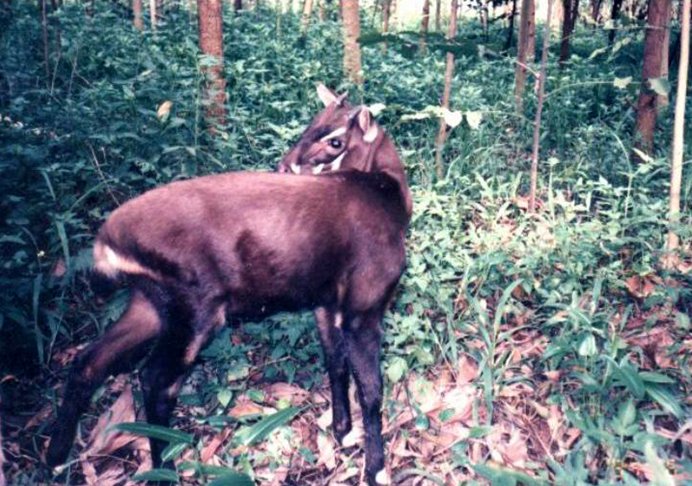| 새로운 사진 | 신문속의 동물소식 | 신기한 동물이야기 | 동물의 소리 | 동물동화상 | 사진 올리기 | 사진 저작권 | English |
|---|
| 재미있는 동물사진 | 괴수/괴어/엽기 동물사진 | 동물이름사전 | 동물목록 | 바깥고리 | 창고입구 | 똑똑누리집 |
|---|
| 이미지 정보 | Original File Name: Saola, Vu Quang Ox (Pseudoryx nghetinhensis).jpg Resolution: 692x486 File Size: 105046 Bytes Upload Time: 2007:10:16 22:06:44 | |
| 올린이 | 이름 (메일주소): Unknown | |
| 사진 제목 | Saola, Vu Quang Ox (Pseudoryx nghetinhensis) - Wiki | |
 |
| Email : 카드 | 올린이 | 운영자 사진삭제 정보수정 Admin |
| 설명 | Saola, Vu Quang Ox (Pseudoryx nghetinhensis) - Wiki
Saola
The Saola or Vu Quang ox, also, infrequently, Vu Quang bovid (Pseudoryx nghetinhensis), one of the world's rarest mammals, is a forest-dwelling bovine found only in Vietnam (Vu Quang Nature Reserve) and in Laos, near the Vietnam-Laotian border. Its name Saola means spindle-[horned]. The scientific epithet nghetinhensis refers to the two Vietnamese provinces of Nghe An and Ha Tinh while Pseudoryx acknowledges the animal's similarities with the Arabian or African oryx. The Hmong natives call this beast saht-supahp, a term derived from Lao meaning "the polite animal", because it moves quietly through the forest. Saolas have only been known to zoologists since 1992, from several pairs of unusual horns obtained in Vietnam. Chromosomic analysis has since revealed that this is a new ruminant genus, related to cows, anoas, kudus or elands. It is still uncertain whether they are cattle, antelope or goats. It is not known how many of this species exist, as only 11 have been recorded alive. They can occasionally be viewed at General Cheng's zoo in Lak Xao, Laos. Habitat and distribution The saola occurs in the Annamite Range's moist forests and the Eastern Indochina dry and monsoon forests. They have been spotted in steep river valleys at about 300 to 1800 m above sea level. These regions are distant from human settlements, covered primarily in evergreen or mixed evergreen and deciduous woodlands. The species seems to prefer edge zones of the forests. Saolas stay in mountain forests during the wet seasons, when water in streams and rivers is abundant, and move down to the lowlands in winter. They are shy and never enter cultivated fields or come close to villages. To date, all known captive saolas have died, leading to the belief that this species cannot live in captivity. Description The saola stands about 85 cm at the shoulder and weighs approximately 90 kg. The coat is a dark brown with a black stripe along the back. Its legs are darkish and there are white patches on the feet, and white stripes vertically across the cheeks, on the eyebrows and splotches on the nose and chin. All saolas have slightly backward-curved horns, which grow to half a metre in length. Local populations report having seen saolas traveling in packs of two or three, rarely more. Saola mark their territories by opening up a fleshy flap on their snout to reveal scent glands. They subsequently rub the underside against objects leaving a musky, pungent paste. The saolas' colossal scent glands are thought to be the largest of any living mammal. Diet They are reported to eat small leafy plants???especially fig leaves, and stems along rivers. Saolas generally live in small groups of less than five animals. The animal seems to have a browsing diet, considering its small incisors. Threat The major threat is hunting???the species' meat being highly appreciated by local people???and degradation of its forest habitats in the region. http://en.wikipedia.org/wiki/Saola
| |||
| 저작권 정보 | 사진의 저작권은 원저작자에게 있습니다. 동물그림창고는 동물관련 사진을 전시할 수 있는 공간만을 제공합니다.사진을 사용하고자 할 경우에는 저작권자와 협의하시기 바랍니다. |
|
|
|
| |||||||
| CopyLeft © since 1995, 동물그림창고. All rights may be reserved. | ||||||||
Stats